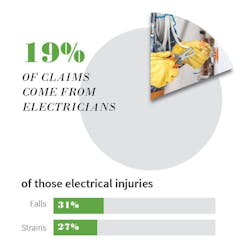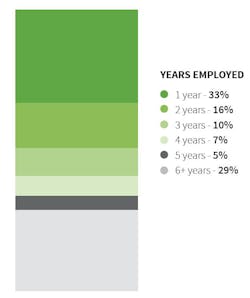Sobering Stats for Electrical Contractor Workers’ Comp Claims
Curious whether your workers’ compensation claims experience is in line with that of the rest of the specialty contracting world? A leading insurer may have some answers.
AmTrust Financial Services, Inc.’s, recent report that examined a decade’s worth of claims (some 26,000 in total) from electrical, plumbing, HVAC, carpentry, and similar contractors shows that claims among that group skew to younger companies and newer workers; injuries from falls, strains, and burns are common and often consequential; and claims-inducing injuries peak in the summer months.
If you’re an electrical contractor with claims experience, you are not alone. That specialty accounted for 19% of the AmTrust claims filed, second only to plumbers, who filed 28%, possibly reflecting outsized representation among the contractors covered, but perhaps indicative, too, of the presence of more workplace- or task-related dangers than other contractors.
Owing to routine work around electricity, electrical contractors might seem the most at risk among specialty contractors for worker injuries and claims. When it comes to chronic workers’ compensation issues, however, the big risk probably doesn’t come from contact with high voltage, but instead routine, day-to-day activities. AmTrust says 31% of claims from electricians were due to falls, while 27% were tied to sprains, in line with numbers for plumbers.
Falls have been getting more attention in construction workplace safety circles, and the report helps confirm the need. The median amount of lost work time due to falls or slips was 21 days, with 34 days the median for falls from ladders or scaffolding, which along with lifting strains produced the most claim-producing injuries (Fig. 1).
By comparison, the median lost time for all injuries was 13 days. Others exceeding that included burns at 19 days and cuts at 14 days. At 11 days, strains came in under the all-injury average, but those related to repetitive motion and reaching were 23 and 17, respectively. Injuries that resulted in the most lost workdays were falls, burns, and abrasions.
Recuperation times for workers employed by artisan contractors could be poised to move higher because the workforce is aging. While employees with less than a year of experience accounted for one-third of the claims AmTrust examined, those with six-plus years accounted for almost another third (Fig. 2).
That might suggest that younger workers are getting injured because they’re less experienced, but older workers are getting injured because their bodies are more at risk and may be less supple.
“The median age for a worker claim was 44, older than we find in most other industries we cover,” says Matt Zender, senior vice president for workers’ compensation strategy. “As the industry, and maybe electrical contractors, in particular, find it harder to find good workers to replace those leaving the industry the result is less properly trained and less skilled individuals. One thing we find is that as you move from journeyman to master electrician, there’s a likelihood of claims going down because you’ve been doing it longer and know how to work safely. But when you’re a master and you’re injured, you’re more likely to have a more severe claim because you can’t bounce back as easily. So as the frequency of claims drops, their severity may increase.”
The riskiest workers’ compensation scenario might be less skilled workers employed by companies just getting started in business. AmTrust found that specialty contractors in business less than four years accounted for 75% of all claims. Whether it’s because they have so many balls in the air trying to get established or they lack the resources to devote to safety, younger companies are the source of more claims. But young or established, Zender says contractors are constantly challenged to keep safety top of mind — and that can be consequential.
“In the contractor space, we know that owner-operators are wearing many hats, and many are working from the dashboards of their trucks,” he says. “While we don’t expect to see them always prioritizing safety above making a profit or customer service, companies that do so can have an advantage. Most are cognizant of their insurance spend and understand that paying attention to safety and getting credits (for fewer claims) can allow them to bid more competitively than the guy down the street who isn’t getting them.”
The key to keeping the most common claims down, Zender says, is understanding risk and ensuring that employees are trained and take the time needed to perform routine tasks safely, information AmTrust provides for fall protection, for example. Inattention due to productivity demands and heavy work schedules probably leads to many such injuries, and there’s some evidence that contractors under the gun in that regard might sustain more worker mishaps. In addition, AmTrust’s report found claims peaked in the summer months when companies might be loaded with work and stretched more thinly. Contractors in regions that allow more year-round work also had more claims. Thus, Arizona claims were 42% higher than the national average, and Florida’s were 34% higher.
Tom Zind is a freelance writer based in Lees Summit, Mo. He can be reached at [email protected].
About the Author
Tom Zind
Freelance Writer
Zind is a freelance writer based in Lee’s Summit, Mo. He can be reached at [email protected].


